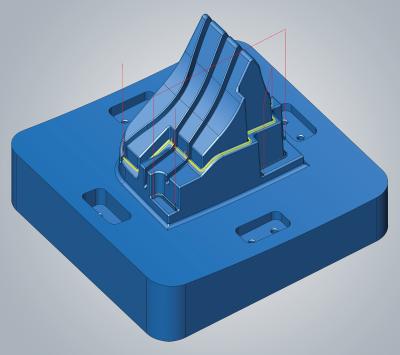
OPEN MIND Technologies AG, a leading developer of CAD/CAM software solutions worldwide, has introduced its latest hyperMILL® 2021.1 CAD/CAM software suite which offers users new and enhanced features for efficient 3D, 5-axis and mill/turn machining. Key innovations include a new “Interactive Edit Toolpath” capability which enables toolpath editing after initial toolpath generation. Especially productive for optimizing tool and mold making, the new toolpath editing feature is easy-to-use, and offers programmers the flexibility to adapt toolpaths by trimming and removing sequences accordingly for component conditions.
To streamline access to Product Manufacturing Information (PMI) and metadata, hyperMILL® 2021.1 offers a new import function that retrieves face quality information and metadata when importing CAD data from neutral or native formats, and attaches data to the imported faces in hyperCAD®-S, making the information available to hyperMILL® and its machining processes.
"We are dedicated to maximizing and simplifying the user experience with hyperMILL® by adding innovative and enhanced features and strategies," said Mr. Alan Levine, Managing Director of OPEN MIND Technologies USA, Inc. "Keeping pace with evolving CAD/CAM programming requirements, and laying the foundation for future needs are both vital. In one example, the new PMI and Metadata Import feature in hyperMILL® 2021.1 supports future-oriented data formats that will eventually eliminate the need for blueprints."
A new 5-axis Radial Machining strategy allows bottle shapes and similar cavities to be easily and efficiently programmed in hyperMILL®, resulting in high quality surface finishes. Using a new radial projection method, toolpaths are calculated quickly so that the most productive machining strategies can be applied. For optimal high precision machining, hyperMILL® “High Precision Surface Mode” and “Smooth Overlap” strategies can also be applied when using 5-axis Radial Machining, ensuring the best surface quality and clean transitions.
For high quality surface finishes and to simplify programming when flank and point milling blades, hyperMILL® 2021.1 offers several enhanced Multi-Blade strategies. No longer do blade surfaces need to be ruled for accurate programming results. Using the enhanced strategies, any number of surfaces are permitted for the suction and pressure sides, making it exceptionally easy to extend blade surfaces. Fillets with a variable radius are supported in the latest version of hyperMILL®. Also, for high accuracy, the enhanced Multi-Blade flank milling strategies result in smaller deviations on the suction and pressure side, and offer improved tool guidance along the upper boundary in the edge area.
hyperMILL® 2021.1 provides a new, powerful SIMULATION Center for generic NC data in turning and milling operations. Modeled after the hyperMILL® VIRTUAL Machining Center, the new, modern SIMULATION Center is integrated in hyperMILL®, and offers an intuitive operating environment for faster simulation, independent collision checking and extensive analysis functions.
Additional new features in hyperMILL® 2021.1 include a new, easy-to-use “XY Optimization” command for optimal 3D profile finishing. In the hyperMILL® Mill-Turn Module, the high-performance mode has been integrated into a 3-axis simultaneous roughing strategy, combining the advantages of HPC and simultaneous turning. For the simplified alignment of components, hyperCAD®-S has a new “Align Best Fit” machining command that allows like-geometry components to be aligned with one another using defined pairs of points.
Contact Details
Related Glossary Terms
- computer-aided design ( CAD)
computer-aided design ( CAD)
Product-design functions performed with the help of computers and special software.
- gang cutting ( milling)
gang cutting ( milling)
Machining with several cutters mounted on a single arbor, generally for simultaneous cutting.
- machining center
machining center
CNC machine tool capable of drilling, reaming, tapping, milling and boring. Normally comes with an automatic toolchanger. See automatic toolchanger.
- milling
milling
Machining operation in which metal or other material is removed by applying power to a rotating cutter. In vertical milling, the cutting tool is mounted vertically on the spindle. In horizontal milling, the cutting tool is mounted horizontally, either directly on the spindle or on an arbor. Horizontal milling is further broken down into conventional milling, where the cutter rotates opposite the direction of feed, or “up” into the workpiece; and climb milling, where the cutter rotates in the direction of feed, or “down” into the workpiece. Milling operations include plane or surface milling, endmilling, facemilling, angle milling, form milling and profiling.
- numerical control ( NC)
numerical control ( NC)
Any controlled equipment that allows an operator to program its movement by entering a series of coded numbers and symbols. See CNC, computer numerical control; DNC, direct numerical control.
- precision machining ( precision measurement)
precision machining ( precision measurement)
Machining and measuring to exacting standards. Four basic considerations are: dimensions, or geometrical characteristics such as lengths, angles and diameters of which the sizes are numerically specified; limits, or the maximum and minimum sizes permissible for a specified dimension; tolerances, or the total permissible variations in size; and allowances, or the prescribed differences in dimensions between mating parts.
- toolpath( cutter path)
toolpath( cutter path)
2-D or 3-D path generated by program code or a CAM system and followed by tool when machining a part.
- turning
turning
Workpiece is held in a chuck, mounted on a face plate or secured between centers and rotated while a cutting tool, normally a single-point tool, is fed into it along its periphery or across its end or face. Takes the form of straight turning (cutting along the periphery of the workpiece); taper turning (creating a taper); step turning (turning different-size diameters on the same work); chamfering (beveling an edge or shoulder); facing (cutting on an end); turning threads (usually external but can be internal); roughing (high-volume metal removal); and finishing (final light cuts). Performed on lathes, turning centers, chucking machines, automatic screw machines and similar machines.

